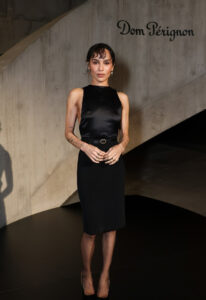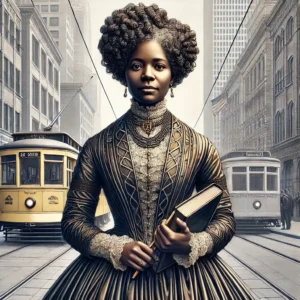If the walls of the Tate Modern’s Blavatnik Building could talk, they might have something new to say after Dom Pérignon took over its cavernous halls for an evening that married the champagne house’s storied history with the disruptive pulse of contemporary artistry. On this rare night, the stark industrial canvas of the Tate was transformed into an immersive arena of light, rhythm, and transcendental glamour—an unfolding tableau where Anderson .Paak spun records under glistening spotlights and Tilda Swinton twirled like a wraith in silk to the beat of Missy Elliott.
This was not a launch party. It was a living installation—part homage, part celebration—for Dom Pérignon’s newest campaign, Creation Is An Eternal Journey. The champagne maison, long synonymous with opulence and reverence, stretched its cultural vocabulary far beyond the flute, stepping confidently into the avant-garde. In collaboration with photographer Collier Schorr and filmmaker Camille Summers-Valli, the campaign brought together a multigenerational pantheon of artists: Swinton, Zoë Kravitz, Iggy Pop, Takashi Murakami, Clare Smyth, Anderson .Paak, and choreographer Alexander Ekman. The result was less a campaign than a manifesto—one that asked, with champagne in hand: what is creation, if not eternal?
The Alchemy of the Setting
The Tate Modern is no stranger to grandeur. With its brutalist symmetry and weighty silence, it typically gives over its galleries to the dialogue of stillness and canvas. But last night, the setting changed tone and tempo. The Blavatnik Building’s lower levels—usually echoing with curatorial whispers—became an electric pulse of gold lights, mirrored orbs, and minimalist sculptures hinting at wine casks and ancient amphorae.
Dom Pérignon’s staging was meticulous. The lighting scheme borrowed from James Turrell’s principles of perception, suffusing the space with a warm hum that seemed to soften the concrete’s bite. Installations of blown glass evoked bubbles suspended mid-effervescence, while artful floral arrangements—anemones, peonies, thistles—offered bursts of organic asymmetry. It was an environment tailored not for spectacle, but for communion: between artists, ideas, and the perpetual tension between refinement and abandon.
The Icons Arrive
There’s a particular soundlessness that follows the entrance of legends. Tilda Swinton, ethereal as ever, arrived in a monochromatic ensemble that oscillated somewhere between ecclesiastical and futuristic. She moved through the crowd like a line drawing—precise, abstract, ephemeral. Anderson .Paak wore a velvet two-piece the color of midnight Merlot, his grin visible from across the room. Iggy Pop, ageless and wiry, prowled the perimeter with the curiosity of a fox in a sculpture garden. Takashi Murakami, radiant in patterned pastels, seemed to blur the boundary between guest and artwork.
The guest list was a convergence of spheres: fashion editors, contemporary artists, Michelin-star chefs, sound designers, cultural theorists, and the occasional royal adjacent. And yet the evening lacked pretense. There was a looseness in the air, as though the act of gathering—after years of aesthetic overstimulation and cultural burnout—had returned to something sacred.
Jefferson Hack, co-founder of Dazed and co-conspirator in the campaign, served as interlocutor-in-chief. He had, over the course of the campaign’s creation, sat with each figure featured to discuss the roots and residues of their creative practices. “The point wasn’t just to document genius,” he noted during the evening. “It was to make visible the conditions that nourish it.”
Creation as Ritual, Not Product
The campaign’s guiding phrase—Creation Is An Eternal Journey—functioned not as a slogan, but as an invocation. Each artist featured in the visual work was asked not to pose, but to participate. Collier Schorr’s photographic language, at once restrained and deeply emotive, rendered each subject as part myth, part memory. Tilda Swinton’s image is a chiaroscuro of movement—an almost ecclesiastical presence captured mid-ritual. Iggy Pop appears not as an icon of rebellion, but as a creature of physical inquiry, skin and sinew held in tension with time.
Camille Summers-Valli’s short film counterpart complements the stillness with velocity—movement as metaphor, rhythm as process. Shot across varied terrains and lit in stark natural light, the film traces the cyclical labor of creative practice: not arrival, but return; not mastery, but reinvention. In a particularly striking scene, Zoë Kravitz walks silently through a mirrored corridor that seems to multiply her into infinite versions of herself. “There is no final form,” she murmurs off-screen. “Only endless becoming.”
The Sonic Shift: Anderson .Paak Behind the Decks
As the evening slipped deeper into intoxicated reverie, Anderson .Paak made his way to the DJ booth, replacing the ambient minimalism with something less contemplative and more carnal. The beat dropped to Missy Elliott’s “She’s a Bitch,” and the room caught fire. Swinton—who until then had remained statuesque—let the rhythm enter her bones. She danced, not as a performer but as a vessel, shaking off the solemnity of the white cube and surrendering to the primal.
It wasn’t spectacle. It was spiritual. Guests followed, hesitantly at first, then in clusters—editors, curators, strangers. There was a sense of old ceremony returning to new form: the artists’ salon reimagined as a disco-lit temple, held together not by theory or critique, but by motion and presence.
Anderson .Paak’s set was a love letter to syncopation—Prince, Erykah Badu, early OutKast, the occasional Kendrick deep cut. The champagne flowed, but not for indulgence—for communion. Dom Pérignon was passed not in flutes, but in generous glassware, poured with the democratic spirit of water at a village well.
The Legacy of Collaboration
Dom Pérignon’s ongoing alignment with contemporary creatives is no marketing stunt. Since its landmark collaboration with David Lynch in 2012 and subsequent partnerships with Lady Gaga, Björk, and Lenny Kravitz, the brand has demonstrated a sustained interest in the deeper ecology of creative minds. It understands that champagne, like art, is not simply the result of good ingredients. It’s the distillation of time, attention, and risk.
What distinguishes this latest campaign is its refusal to present creativity as a finished product. Instead, Creation Is An Eternal Journey frames the act as recursive, uncertain, and luminous. It affirms that the artist does not arrive; they orbit. They don’t deliver answers—they generate space.
This ethos is mirrored in the way Dom Pérignon approaches its own craft. The vintage-only principle—where no bottle is made unless the year’s harvest is deemed exceptional—parallels the artistic commitment to integrity over productivity. As Chef de Cave Vincent Chaperon has said, “Every vintage is an act of faith. We don’t repeat. We reimagine.”
Tilda, Iggy, Murakami: A Trinity of Creation
If Swinton was the spirit of the evening, Iggy Pop was its pulse, and Murakami its prism. Together, they formed a loose trinity of creative ethos. Swinton brings the cerebral, the liminal, the mythic. Iggy offers the body, the edge, the animal. Murakami refracts culture itself—pop, history, tradition—into something at once hyper-real and tender.
In one corner of the Tate’s lower hall, a projection of Murakami’s Time Bokan characters spiraled across the walls in iridescent animation. Nearby, Swinton posed with a young performance artist whose hair had been sculpted into a baroque headpiece of poured resin. Iggy stood alone at one point, staring up at a glass sculpture that seemed to pulse with internal light. He wasn’t performing. He was feeling.
Closing the Night: A Toast Without End
As midnight approached, there was no official end. No speech. No final flourish. Just a gradual exhale. The guests lingered, reluctant to fracture the equilibrium that had formed. Someone passed around Polaroids taken over the night—grainy, euphoric, real. One captured a champagne bottle held aloft mid-dance. Another showed a silhouette against an installation that looked like a fossilized storm cloud.
Tilda Swinton remained near the DJ booth, eyes closed, still swaying. When asked what creation meant to her, she responded simply: “Stillness and sound, both in the same breath.”
That is what this night was: the stillness of intention, the sound of becoming, and the shimmer of champagne in the spaces in between.
The Journey Never Ends
Dom Pérignon’s event at the Tate was not about luxury. Not really. It was about process. About what happens when creation is treated not as currency, but as communion. The presence of Swinton, .Paak, Iggy Pop, Murakami, and others served to underscore the idea that creation does not sit on a pedestal. It moves. It dances. It listens.
The champagne was exquisite, yes. But it was never the centerpiece. The centerpiece was the shared understanding that to create—again, and again—is the most human thing we do.
And in that, Dom Pérignon’s campaign becomes not just a narrative, but a reminder: that the journey, like the vintage, is never duplicated. It is always made anew.
No comments yet.








